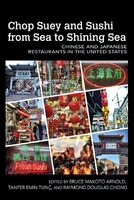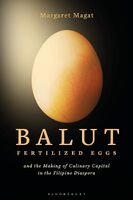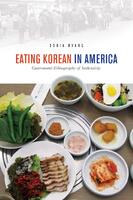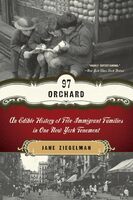-

-

This book investigates the transformation of Chinese food in the U.S. after 1965, analyzing its symbolic meanings and cultural functions. It explores how Chinese food mirrored and shaped the relations between the Chinese community and mainstream white society, with a specific focus on the social and cultural shifts in California.
-

"Flavors of Empire" explores the rise of Thai food in America, particularly in Los Angeles during the 1980s, and how it shaped Thai American identity. The book discusses how Thai immigrants adapted and marketed their cuisine to suit American tastes, and how these shifts in food culture reveal the racial and ethnic dynamics of the Thai American experience.
-

"Creole Italian" explores the impact of Sicilian immigrants on New Orleans' food culture from the mid-1830s to the 1970s. The book argues that their influence on the city's foodways, traditionally undervalued, significantly contributed to shaping the food landscape of New Orleans, along with African, French, and Spanish culinary traditions.
-

"Eating Asian America: A Food Studies Reader" is a collection of scholarly works exploring how various food and culinary practices shape the understanding of Asian American identity. It investigates the impact of class, race, ethnicity, and gender dynamics on the creation and perception of Asian American groups and food landscapes, as well as challenges the concepts of authenticity and Americanness.
-

"Chop Suey and Sushi from Sea to Shining Sea" is a collection of essays that explore and contextualize the histories of Chinese and Japanese restaurants in the United States, revealing their impact on American culture, politics, and food traditions. The book offers a diverse perspective on the evolution of these cuisines in the US and highlights the resilience strategies employed in Asian restaurant kitchens, contributing to the broader field of American food studies.
-

Chef and writer Edward Lee spent two years traversing America to uncover intriguing food stories. His book encapsulates sixteen adventure narratives about food traditions from around the world, now rooted in different corners of the country, and the individuals who uphold them. The book chronicles Lee's journey through a Uyghur cafe in New York, a Korean restaurant in Alabama, a German sausage shop in Wisconsin, and more, revealing a fresh new page of American cuisine. Inspired by these experiences, Lee has also created forty new recipes that allow us to introduce these diverse dishes to our own kitchens.
-

This book delves into pressing issues in American society by intersecting food and immigration at two levels: the macro-level of national policy and the micro-level of immigrants' daily food habits. Centered on the "immigrant-food nexus," the chapters analyze the evolving relationships between food systems, immigration policy, and immigrants' food practices.
-

This book explores the relationship between food and identity among Nigerian migrants in Belgium, focusing on how diet influences their self-perception and engagement with others. It highlights the persistence of Nigerian culinary habits in the diaspora, despite the new environment, and the role of food in both affirming cultural identity and facilitating trans-regional conversations.
-

This book provides a thorough analysis of "washoku," or Japanese cuisine, delving into its history, practice, and cultural significance. It investigates how the values inherent in Japanese food and culinary customs contribute to shaping the national identity of Japan. Many chapters also discuss how "washoku" is perceived and interpreted within global cultural exchanges.
-

"Inscrutable Eating" by Jennifer Lin LeMesurier explores how assumptions about Asian food shape the perception of Asian and Asian American identity within the US, demonstrating that beliefs about food choices are inseparable from attitudes around racial, gender, and social hierarchies. She develops the concept of "gut orientations" to analyze how these food-related reactions establish certain racial views as common-sense truths, ultimately highlighting the necessity of challenging broader forms of discrimination.
-

This collection of conference papers provides insights into the symbolic and material aspects of food practices. It explores the negotiation of communities and identities through the preparation and consumption of food, as well as emphasizes how socioeconomic power relations have influenced the reinvention of Caribbean and Western identities in the context of migration and transnationalism.
-

Delving into the tradition and popular perception of the dish balut (an embryonated chicken or duck egg), Margaret Magat investigates how the global consumption of this Filipino dish mirrors identity politics, evolving cultural attitudes, and the interplay between migration and globalization.
-

"Food Parcels in International Migration: Intimate Connections" highlights the materiality of global connections within conversations about migration and transnationalism. The chapters use food and related customs as a lens to examine how local experiences intersect with global influences. Food parcels provide an insightful starting point for studying relationships, intimacy, consumption, exchange, and other pivotal anthropological topics in various social and economic contexts.
-

Food, according to Anita Mannur, plays a pivotal role in the cultural imagination of diasporic communities. Examining how food is featured in various forms of expression, her book “Culinary Fictions” delves into the cultural output of the South Asian diaspora as it extends into Anglo-American territories. Mannur uses various texts, including novels like Chitra Divakaruni’s Mistress of Spices and Shani Mootoo’s Cereus Blooms at Night, and cookbooks such as Madhur Jaffrey’s Invitation to Indian Cooking and Padma Lakshmi’s Easy Exotic, to show how national identities are shaped through culinary practices.
-

"The Immigrant Kitchen: Food, Ethnicity, and Diaspora" is a comprehensive examination of food memoirs by immigrants and their descendants. This book explores how these memoirs use homemade food as a lens to express concerns about immigrant identity, as well as the assimilation and acculturation process in the United States. By combining personal anecdotes, recipes, cultural insights, and discussions about life away from their homeland, these memoirs illuminate the profound impact of immigration on individuals and their American-born families across generations.
-

"Food in Memory and Imagination" encompasses 25 case studies examining how food plays a role in people's interaction with their past, present, and future. Drawing on cases from diverse global locations, including Iran, Italy, Japan, Kenya, and the US, the chapters explore a myriad of issues through the perspectives of anthropology, history, and sociology. While not all chapters specifically address the topic of diaspora, the theme of memory and imagination ties closely to how food acts as a powerful vehicle for sparking memories, crafting imagination, and fostering community among displaced individuals.
-

How is the concept of “home” negotiated around food in worldwide diaspora communities? How are cultural boundaries upheld, strengthened, or questioned among groups inhabiting the same space? "Food Identities at Home and on the Move" includes twelve thoughtful case studies on food and migration. Each one presents a unique narrative about the connection between culinary traditions and differing perceptions of home and dwelling.
-

In "Eating Korean in America: Gastronomic Ethnography of Authenticity", Sonia Ryang applies the ethnographic approach to explore the world of Korean food across four American locations, Iowa City, Baltimore, Los Angeles, and Hawaii. Drawing upon her firsthand experiences and observations, Ryang explores the interconnections between food, colonial histories, ethnic displacements, and global capitalism, as well as encourages readers to think about the complex layers of authenticity and cultural identity in the food we eat.
-

Weaving recipes, essays, poetry, and visual art into "Black Food," Bryant Terry creates “a communal shrine
to the shared culinary histories of the African diaspora.” It’s not only a mouth-watering cookbook,
but also a collection of stories, lifestyles, and explorations of justice across diaspora communities.
-

"From the Jewish Heartland: Two Centuries of Midwest Foodways" is a comprehensive exploration of Jewish culinary traditions in the American Midwest from the 1800s to the present. The authors, Ellen F. Steinberg and Jack H. Prost, delve into various sources to study the transformation and adaptation of traditional Jewish recipes by immigrants in the region. The book provides a unique journey through midwestern Jewish culinary history, considering the impact of immigration, relocation, and Americanization processes, and includes dozens of sample recipes.
-

"High on the Hog" is not only a cookbook but also an engaging history of the African Diaspora and African American food traditions. Tracing the stories of people and food along the paths of the diaspora across the Atlantic, Jessica B. Harris celebrates the diverse foodways as a significant part of African American history, culture, and identity.
-

"Soul and Spice" is a recipe collection that spotlights African-influenced cuisines from the Western hemisphere. This includes dishes from the Caribbean, American South, and Brazil, as well as a special chapter dedicated to the cooking of recent African immigrants to the Americas. The recipes are sorted by food style, such as Soul Food, Barbecue, and Louisiana Creole. They're also categorized by place of origin like Bahia, Brazil, and the Caribbean, and by the people who brought them to America. Each recipe is complemented by detailed notes that provide historical context and personal anecdotes.
-

"The Settler's Cookbook" is a personal memoir that explores the history of Indian migration to the UK via East Africa through the lens of food and cooking. Yasmin Alibhai-Brown shares her family's journey from India to East Africa during British imperial expansion, their displacement from Uganda in 1972, and their subsequent relocation to the UK. The book delves into the hybrid culinary traditions of Yasmin's family through their unique recipes. For example, who would have thought a curry dish could be enhanced by adding ketchup?
-

In the early 20th century, the culinary landscape of New York’s Lower East Side tenement apartments was diverse and rich in stories. This book delves into the lives of five immigrant families residing at 97 Orchard Street, exploring how their German, Irish, Italian, and Eastern European Jewish heritages shaped their foodways. Including forty recipes, this book offers readers an immersive insight into New York’s immigrant culture.
























